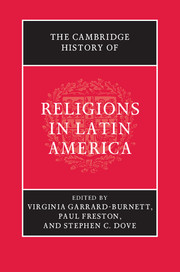Book contents
- The Cambridge History of Religions in Latin America
- The Cambridge History of Religions in Latin America
- Copyright page
- Dedication
- Contents
- Tables and Figure
- Contributors
- Book part
- 1 Introduction to the Cambridge History of Religions in Latin America
- 2 Religion in the Pre-Contact New World
- 3 Religion in the Pre-Contact Old World
- 4 Religion in the Pre-Contact Old World
- 5 Extending Christendom
- 6 New World “Savages,” Anthropophagy, and the European Religious Imagination
- 7 Evangelization and Indigenous Religious Reactions to Conquest and Colonization
- 8 Tridentine Catholicism in the New World
- 9 The Inquisition in the New World
- 10 Saint, Shrines, and Festival Days in Colonial Spanish America
- 11 The Baroque Church
- 12 The Spanish Missions of North and South America
- 13 The Church, Africans, and Slave Religion in Latin America
- 14 Messianic and Revitalization Movements
- 15 The Expulsion of the Jesuits and the Late Colonial Period
- 16 The Church and Latin American Independence
- 17 Liberalism, Anticlericalism, and Antireligious Currents in the Nineteenth Century
- 18 Religious Devotion, Rebellion, and Messianic Movements
- 19 Historical Protestantism in Latin America
- 20 Immigrant Protestantism
- 21 Marianism in Latin America
- 22 Secularism and Secularization
- 23 The Revival of Latin American Catholicism, 1900–1960
- 24 The Intellectual Roots of Liberation Theology
- 25 Progressive Catholicism in Latin America
- 26 The Catholic Church and Dictatorship
- 27 Latin American Pentecostalism as a New Form of Popular Religion
- 28 History, Current Reality, and Prospects of Pentecostalism in Latin America
- 29 The Religious Media and Visual Culture in Latin America
- 30 The Catholic Charismatic Renewal and the Incipient Pentecostalization of Latin American Catholicism
- 31 Contemporary Popular Catholicism in Latin America
- 32 Catholicism and Political Parties in Modern Latin America
- 33 Human Rights
- 34 Religion and Gender in Latin America
- 35 Christian Churches, Reproduction, and Sexuality in Latin America
- 36 Indigenous Peoples
- 37 Inculturation Theology and the “New Evangelization”
- 38 African Diaspora Religions in Latin America Today
- 39 Afro-Caribbean Religious Expressions
- 40 Spiritism in Latin America
- 41 Transnationalism, Globalization, and Latin American Religions
- 42 Religious Identity and Emigration from Latin America
- 43 Neither Catholics nor Protestants
- 44 Jews and Judaism in Latin America
- 45 Islam in Latin America
- 46 Asian Religions in Latin America
- 47 Ecumenism in Latin America
- 48 The Religious Field in Latin America
- 49 Pathways to the Future
- Index
- References
30 - The Catholic Charismatic Renewal and the Incipient Pentecostalization of Latin American Catholicism
Published online by Cambridge University Press: 05 April 2016
- The Cambridge History of Religions in Latin America
- The Cambridge History of Religions in Latin America
- Copyright page
- Dedication
- Contents
- Tables and Figure
- Contributors
- Book part
- 1 Introduction to the Cambridge History of Religions in Latin America
- 2 Religion in the Pre-Contact New World
- 3 Religion in the Pre-Contact Old World
- 4 Religion in the Pre-Contact Old World
- 5 Extending Christendom
- 6 New World “Savages,” Anthropophagy, and the European Religious Imagination
- 7 Evangelization and Indigenous Religious Reactions to Conquest and Colonization
- 8 Tridentine Catholicism in the New World
- 9 The Inquisition in the New World
- 10 Saint, Shrines, and Festival Days in Colonial Spanish America
- 11 The Baroque Church
- 12 The Spanish Missions of North and South America
- 13 The Church, Africans, and Slave Religion in Latin America
- 14 Messianic and Revitalization Movements
- 15 The Expulsion of the Jesuits and the Late Colonial Period
- 16 The Church and Latin American Independence
- 17 Liberalism, Anticlericalism, and Antireligious Currents in the Nineteenth Century
- 18 Religious Devotion, Rebellion, and Messianic Movements
- 19 Historical Protestantism in Latin America
- 20 Immigrant Protestantism
- 21 Marianism in Latin America
- 22 Secularism and Secularization
- 23 The Revival of Latin American Catholicism, 1900–1960
- 24 The Intellectual Roots of Liberation Theology
- 25 Progressive Catholicism in Latin America
- 26 The Catholic Church and Dictatorship
- 27 Latin American Pentecostalism as a New Form of Popular Religion
- 28 History, Current Reality, and Prospects of Pentecostalism in Latin America
- 29 The Religious Media and Visual Culture in Latin America
- 30 The Catholic Charismatic Renewal and the Incipient Pentecostalization of Latin American Catholicism
- 31 Contemporary Popular Catholicism in Latin America
- 32 Catholicism and Political Parties in Modern Latin America
- 33 Human Rights
- 34 Religion and Gender in Latin America
- 35 Christian Churches, Reproduction, and Sexuality in Latin America
- 36 Indigenous Peoples
- 37 Inculturation Theology and the “New Evangelization”
- 38 African Diaspora Religions in Latin America Today
- 39 Afro-Caribbean Religious Expressions
- 40 Spiritism in Latin America
- 41 Transnationalism, Globalization, and Latin American Religions
- 42 Religious Identity and Emigration from Latin America
- 43 Neither Catholics nor Protestants
- 44 Jews and Judaism in Latin America
- 45 Islam in Latin America
- 46 Asian Religions in Latin America
- 47 Ecumenism in Latin America
- 48 The Religious Field in Latin America
- 49 Pathways to the Future
- Index
- References
- Type
- Chapter
- Information
- The Cambridge History of Religions in Latin America , pp. 462 - 479Publisher: Cambridge University PressPrint publication year: 2016
References
Bibliography and Suggested Readings
- 1
- Cited by

